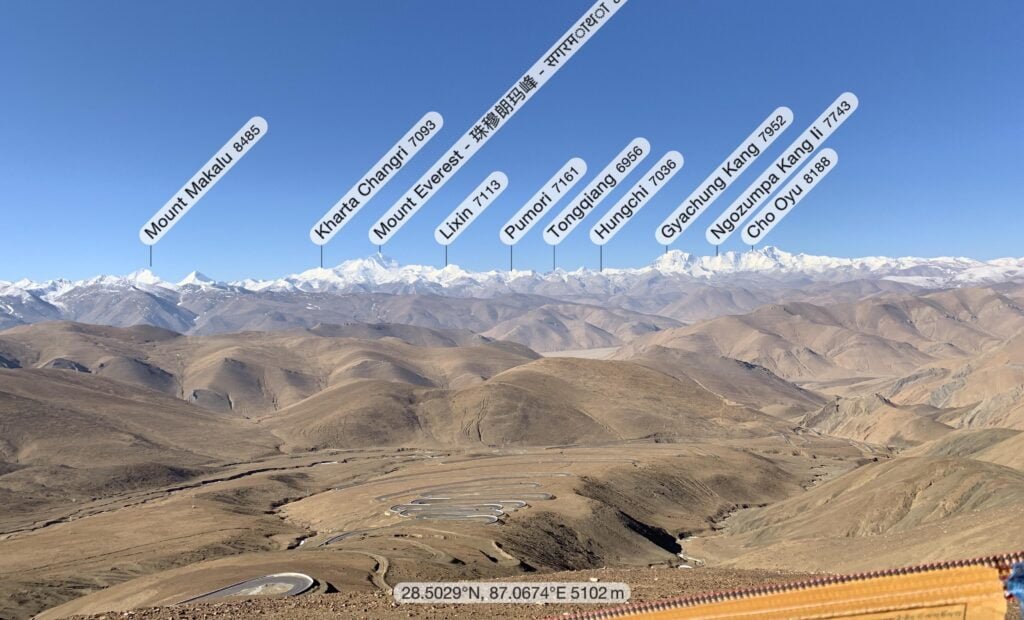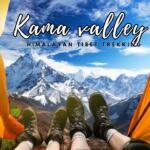Day 1: Arrive in Lhasa
Upon arrival, our guide will welcome you with a traditional Khada scarf. At the high-altitude plateau, it’s important to relax and adapt gradually. Transportation to your hotel will be arranged for rest and acclimatization. Explore the mystical charm of Lhasa, a sacred city for locals and a utopia for tourists, enhanced by the Qinghai-Tibet Railway.
Health Tips:
In Lhasa, avoid strenuous activities and baths on the first day to prevent colds. Stay hydrated, eat lightly, and avoid alcohol. Bring altitude sickness medication like Diamox or Rhodiola rosea. Follow our guide’s advice, rest well, and seek medical help if needed.
Day 2: Lhasa to Kadinggou and Nyingchi
Start early for Nyingchi, travelling along the picturesque Lhasa Nyingchi Expressway, paralleling the scenic Niyang River. The Lhasa Nyingchi Expressway, part of the Sichuan-Tibet and Yunnan-Tibet Highways, showcases the stunning natural beauty of snow-capped plateaus, mountains, forests, and grasslands. Capture this breathtaking scenery on camera!
Kadinggou, a “heavenly place” canyon, offers a walk through a pristine forest with the sound of trickling water, surrounded by lofty mountains, deep valleys, unique rock formations, ancient trees, and bamboo forests.
Day 3: Nyingchi to Sejila Pass, Lulang Forest, and Basum Tso
Sejila Mountain, part of the Nyachen Thanglha range, stands at 4728 meters. It offers views of clouds, forests, and the majestic Namjagbarwa Mountain (7782 meters), celebrated as “China’s most beautiful mountain.”
Lulang Forest Sea is known for its cloud-covered mountains and misty forests, evoking a sense of homesickness. This picturesque valley is flanked by snow-capped mountains and manicured forests.
Special Local Food: Stone Pot Chicken
A Nyingchi delicacy, Stone Pot Chicken is cooked in a unique soapstone pot, enhancing its flavour with local chicken, ginseng, and a mild fragrance of medicinal herbs. These hand-carved pots from Methok are valued for their heat retention and mineral content.
Friendly Advice:
Accommodation in the Basum Tso Scenic Area is limited. If hotels are full, your itinerary may be adjusted to stay in Nyingchi City, with no reimbursement for the price difference. We strive to maintain the overall cost and scheduled attractions and appreciate your understanding.
Day 4: Basum Tso to Jieba Village and Return to Lhasa
Start your day at Basum Tso scenic area, a 5A-level Forest Park, showcasing mountains, lakes, forests, waterfalls, pastures, ancient temples, and more. Enjoy a one-hour tour filled with natural beauty and tranquillity.
Explore the island at the lake’s centre, featuring unique sights like the peach-holding pine, water burial platform, “alphabet tree”, sacred spring, and Tsozong Gompa, a temple representing Tibetan religion-reproductive worship. The temple’s stone steps with male and female figures symbolize life’s respect.
Day 5: Lhasa City Tour – Jokhang Temple, Sera Temple, Barkhor Street
Jokhang Temple: A masterpiece of Tibetan religious architecture, blending design elements from Tibet, the Tang Dynasty, Nepal, and India. Devotees’ adoration is evident on the blue stone floor at the entrance. Essential tip: Book tickets in advance via “Jokhang Temple Reservation” on WeChat, and note that the temple may occasionally close for religious activities. Explore this vibrant street encircling Jokhang Temple, a site for traditional prayer-turning ceremonies. Be cautious when purchasing handicrafts to avoid counterfeit items.
Sera Monastery: A principal Gelug Sect monastery, known for its tens of thousands of Vajra Buddha statues and the Hayagriva statue in Jey Dratsang’s Dharma Protector Temple. Notable for its monk debates, the Sutra Debating Field is a hub of activity and religious discourse, starting around 15:00. Visitors may not grasp the philosophical discussions but can experience the essence of Tibetan Buddhism.
Day 6: Lhasa City Tour – Potala Palace and Tibetan Cultural Experience
Potala Palace: Visit the iconic palace built by Songtsan Gampo. Tickets require a real-name reservation, and you can’t rebook within 7 days of a visit. The travel agency is not liable for entry issues. Group visitors may be split into smaller groups with different guides. Children under 1.2 meters enter free, but those taller must pay for tickets.
Tips for Visiting: Wear flat, comfortable shoes and modest attire. Avoid loud noises, and touching relics, and bring no liquids or flammables. Photography is prohibited. Due to altitude and narrow passages, follow safety instructions and leave promptly after the visit.
Day 7: Lhasa to Yamdrok Yongtso, Karola Glacier, and Shigatse
Yarlung Zangbo River: Enjoy bird’s-eye views of the river, the widest near Lhasa, from Highway 307.
Yamdrok Yongtso Lake: Witness the “angel tears in the sky,” a sacred freshwater lake. It’s a picturesque setting with snow-capped mountains, vibrant villages, and grazing animals. Take photos with local yaks (negotiate prices first). One of Tibet’s three major continental glaciers, situated near Nochin Kangsang Snow Mountain. Despite being partially blackened by road dust, the glacier gleams under sunlight. It’s a few hundred meters from the road and was featured in “Red River Valley.”
Shigatse: Tibet’s second-largest city, historically significant in politics, religion, and culture, and home to the Panchen Lamas. Known for its agriculture, it offers a rich cultural experience.
Travel Reminder: Foreign tourists need a travel permit for Mount Everest visits. The guide will arrange permits and itineraries. Expect possible delays during peak seasons or system malfunctions.
Day 8: Shigatse to Mount Everest via Gyawula Pass
Scenic Route: Travel along a picturesque border road, with views of snow-capped mountains including Kanchenjunga, Lhotse, and Rimana Snow Mountain. The world’s highest peak, standing at 8,848 meters, offers a surreal landscape of snow, glaciers, and towering peaks. The only route to Everest Base Camp, located at 5,200 meters, offers panoramic views of Everest and other 8,000-meter peaks.
At 5,252 meters, this is the highest point on the China-Nepal Highway. Enjoy views of Cho Oyu, Lhotse, Makalu, and Shishabangma. Sunrise visibility is weather-dependent. After experiencing the sunrise at Gyatsola Mountain Pass, you’ll journey back to Shigatse. This leg of the trip allows you to absorb the grandeur of the Himalayan landscape once more, with its towering peaks and vast, serene beauty. The drive back is an opportunity to reflect on the extraordinary experiences you’ve had at some of the world’s highest and most sacred sites.
Near the new Everest Base Camp, Monastery at 5,100 meters offers stunning views and a chance to see the unique Everest banner clouds. Accommodation at Everest camp is in shared tents with basic facilities. From October to April, accommodations shift to homestays due to cold weather. Prepare for basic food, high altitude, and low temperatures. Rentable down jackets are available at the base camp.
Day 9: Mount Everest to Gyatsola Pass and Return to Shigatse
Dress warmly for below-zero temperatures and strong winds at sunrise. Witness the breathtaking view of Mount Everest’s snow-capped peaks and glaciers. Sunrise visibility depends on weather conditions. Returning to Shigatse, you can explore more of this significant city in Tibetan culture and history. As the second-largest city in Tibet, Shigatse offers a blend of modern development and rich cultural heritage, including monasteries and historical sites. It’s an ideal place to relax and unwind after the high-altitude adventures.
Spend your evening strolling through local markets, sampling Tibetan cuisine, or simply resting and preparing for the next leg of your journey. The city, with its unique blend of traditional and contemporary Tibetan life, provides a peaceful and reflective end to an eventful day. After returning from the high altitudes of Mount Everest and Gyatsola Pass, it’s important to monitor your health. The drastic change in altitude can affect individuals differently, so ensure you stay hydrated and get plenty of rest.

Day 10: Shigatse to Tashilhunpo Monastery and Return to Lhasa
Tashilhunpo Monastery: Known as the “Fortunate Monastery,” this is the largest in the Shigatse area and a significant Gelug sect temple. Founded in 1447 by the first Dalai Lama, it once housed over 5,000 monks. Today, it has over 800 monks, 4 Dratsangs, 56 scripture halls, and covers 300,000 square meters.
Highlights: Tashilhunpo is renowned for its Jamba Buddha Hall with a Buddha statue adorned in brass, gold, diamonds, and pearls. The monastery also features an ornate Panchen Lama tomb stupa, richly decorated with precious materials.
Travel Note: This tour includes individual passengers. The agency may arrange a direct trip from Shigatse to Damshung, followed by a visit to Namtso the next day. Please be aware of itinerary changes when returning from Damshung to Lhasa.
Day 11: Lhasa to Namtso and Return
Namtso Lake: Traverse over Nagenla Mountain to reach Namtso, Tibet’s “heavenly Lake.” At 4,718 meters, it’s the world’s highest saltwater lake and Tibet’s second-largest. Surrounded by the Nyachen Tanglha Mountains, plateaus, grasslands, and rich wildlife, it’s a stunning natural wonder.
Special Note: In case of heavy snow in Namtso, causing road closures, the itinerary will adjust to:
- Day 11: Lhasa to Ganden Monastery for a light walk and return to Lhasa.
- Day 12: Departure from Lhasa – schedule flights after 10 AM to allow travel time from the airport.
This journey through Tibet offers a profound exploration of its sacred lakes, historic monasteries, and breathtaking landscapes, concluding with a serene departure from Lhasa, enriched with unforgettable memories.
Day 12: Departure from Lhasa
On the final day of your tour, you’ll depart from Lhasa. After breakfast, ensure you have ample time for the journey to the airport or train station. It’s recommended to schedule your flight or train after 10 AM to accommodate the hour-long drive from the city to the airport.
Reflecting on Your Journey: As you prepare to leave, take a moment to reflect on the rich tapestry of experiences you’ve encountered. From the spiritual heights of Potala Palace and Tashilhunpo Monastery to the natural splendour of Namtso Lake and the majesty of Mount Everest, this journey through Tibet has offered a unique blend of cultural immersion, historical exploration, and natural wonder.
Last Moments in Lhasa: If time permits, enjoy a final stroll through the streets of Lhasa, soaking in the vibrant atmosphere one last time. Visit a local café or shop for any last-minute souvenirs to take a piece of Tibet back home with you.
Departure: As you make your way to Lhasa’s airport or train station, the memories of this extraordinary journey will accompany you, leaving a lasting impression of Tibet’s beauty and cultural richness. The journey may be concluding, but the experiences and insights gained will continue to resonate, inspiring future travels and a deeper appreciation for the diverse and profound landscapes and cultures of our world.
Brief Fee Description
Included:
- Transportation: Basic tourist vehicles without air-conditioning. Unscheduled rest stops.
- Hotel: Standard double rooms. Single rooms at extra cost.
- Meals: Breakfast included. Other meals are not covered.
- Tour Guide: Chinese/English-speaking based on group needs.
- Attraction Tickets: Main attractions as per itinerary.
- Insurance: Travel-related insurance included.
- Extras: Portable oxygen and daily mineral water.
Not Included:
- Personal Expenses: Laundry, calls, snacks, etc.
- Tips: Suggested 30 yuan/day for driver and guide.
- Round-Trip Transport: Not included; extra booking fee for air/train tickets.
Special Notes:
- The itinerary is subject to change due to local conditions.








